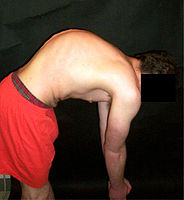
Photo from wikipedia
This study aimed to assess differences in somatosensory control strategies between older patients with sagittal imbalance and young adults during postural tasks. The center of pressure displacement in 27 older… Click to show full abstract
This study aimed to assess differences in somatosensory control strategies between older patients with sagittal imbalance and young adults during postural tasks. The center of pressure displacement in 27 older patients with sagittal imbalance and 27 young adults was determined upon standing blindfolded on a balance board. Vibratory stimulation at 56 to 100 Hz was applied bilaterally to the gastrocnemius and soleus muscles (GS) and lumbar multifidus to evaluate the contributions of proprioceptive signals to postural control. Data of older patients and young adults were compared using the Mann–Whitney U-test or independent sample t-tests. Compared with the young adults, the older patients were significantly more reliant on the GS (p < 0.005) for their postural control and showed a higher relative proprioceptive weighting ratio (RPW) (p = 0.038). The postural strategy adopted by the older patients depended on the level of proprioceptive stimulation applied to the GS, and the postural control strategy of the ankle correlated with RPW. Overall, this study identifies RPW as a novel measure of postural strategy in older patients with sagittal imbalance and provides an understanding of strategies used to maintain balance, which may assist in developing preventative measures to reduce the risk of falls.
Journal Title: Healthcare
Year Published: 2021
Link to full text (if available)
Share on Social Media: Sign Up to like & get
recommendations!